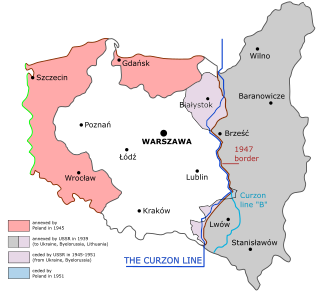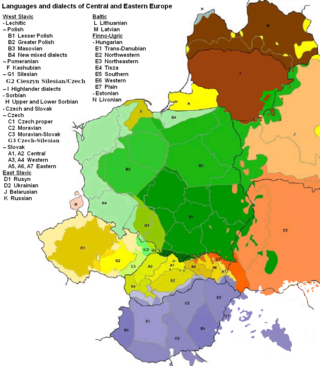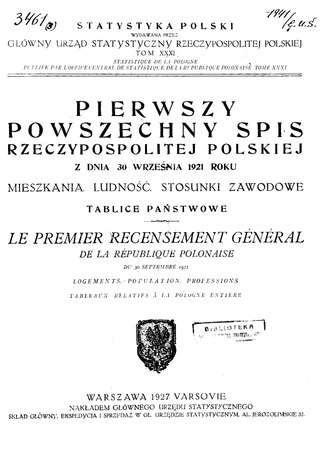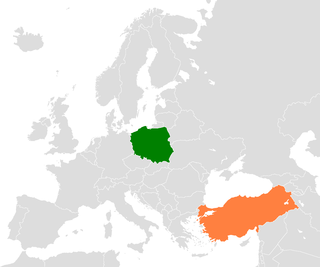Related Research Articles
The Lechiticlanguages are a language subgroup consisting of Polish and several other languages and dialects that were once spoken in the area that is now Poland and eastern Germany. It is one of the branches of the larger West Slavic subgroup; the other branches of this subgroup are the Czech–Slovak languages and the Sorbian languages.

Polish people, or Poles, are a West Slavic ethnic group and nation who share a common history, culture, the Polish language and are identified with the country of Poland in Central Europe. The preamble to the Constitution of the Republic of Poland defines the Polish nation as comprising all the citizens of Poland, regardless of heritage or ethnicity. The majority of Poles adhere to Roman Catholicism.

The Curzon Line was a proposed demarcation line between the Second Polish Republic and the Soviet Union, two new states emerging after World War I. Based on a suggestion by Herbert James Paton, it was first proposed in 1919 by Lord Curzon, the British Foreign Secretary, to the Supreme War Council as a diplomatic basis for a future border agreement.

Silesian, occasionally called Upper Silesian, is an ethnolect of the Lechitic group spoken by part of people in Upper Silesia. Its vocabulary was significantly influenced by Central German due to the existence of numerous Silesian German speakers in the area prior to World War II and after. The first mentions of Silesian as a distinct lect date back to the 16th century, and the first literature with Silesian characteristics to the 17th century.

Silesians is both an ethnic as well as a geographical term for the inhabitants of Silesia, a historical region in Central Europe divided by the current national boundaries of Poland, Germany, and Czechia. Historically, the region of Silesia has been inhabited by Polish, Czechs, and by Germans. Therefore, the term Silesian can refer to anyone of these ethnic groups. However, in 1945, great demographic changes occurred in the region as a result of the Potsdam Agreement leaving most of the region ethnically Polish and/or Slavic Upper Silesian. The Silesian language is one of the regional languages used in Poland alongside Polish as well as Kashubian and is structured with in a SVO format, however the grammar is quite often different to that of the other Lechitic languages. The names of Silesia in different languages most likely share their etymology—Polish: ; German: Schlesienpronounced[ˈʃleːzi̯ən] ; Czech: Slezsko ; Lower Silesian: Schläsing; Silesian: Ślōnsk ; Lower Sorbian: Šlazyńska ; Upper Sorbian: Šleska ; Latin, Spanish and English: Silesia; French: Silésie; Dutch: Silezië; Italian: Slesia; Slovak: Sliezsko; Kashubian: Sląsk. The names all relate to the name of a river and mountain in mid-southern Silesia, which served as a place of cult for pagans before Christianization.
Polish census of 2002 was a census in Poland taken from 21 May to 8 June 2002.
Irish people in mainland Europe are members of the Irish diaspora that reside in Continental Europe. Most of them live in France, Germany and Spain, with smaller numbers in Belgium, the Netherlands, Italy, Greece, Latvia, Lithuania, Poland, and historically Greater Russia.

Ukrainians in Poland have various legal statuses: ethnic minority, temporary and permanent residents, and refugees. According to the Polish census of 2011, the Ukrainian minority in Poland was composed of approximately 51,000 people. Some 38,000 respondents named Ukrainian as their first identity, 13,000 as their second identity, and 21,000 declared Ukrainian identity jointly with Polish nationality. However, these numbers have changed since the mid-2010s, with a large influx of economic immigrants and students from Ukraine to Poland, with some estimating their total number at 2 million people. Their status has been regulated according to the Polish and European Union (EU) policies of temporary work permits, temporary residence permits and permanent residence permits. The number of Ukrainians in Poland rose dramatically following the Russian invasion of Ukraine on 24 February 2022. By 16 August 2022, more than 11.2 million Ukrainian refugees left the territory of Ukraine, of which more than 5.4 million people fled to neighbouring Poland.
After centuries of relative ethnic diversity, the population of modern Poland has become nearly completely ethnically homogeneous Polish as a result of altered borders and the Nazi German and Soviet or Polish Communist population transfers, expulsions and deportations during and after World War II. Ethnic minorities remain in Poland, however, including some newly arrived or increased in number. Ethnic groups include Germans, Ukrainians and Belarusians.

The Polish census of 1921 or First General Census in Poland was the first census in the Second Polish Republic, performed on September 30, 1921 by the Main Bureau of Statistics. It was followed by the Polish census of 1931.

The Polish census of 1931 or Second General Census in Poland was the second census taken in sovereign Poland during the interwar period, performed on December 9, 1931 by the Main Bureau of Statistics. It established that Poland's population amounted to almost 32 million people.

Polish–Turkish relations are the foreign relations between Poland and Turkey. Both countries are full members of NATO, OECD, OSCE, the Union for the Mediterranean, the Council of Europe and the World Trade Organisation. Poland is a member of the European Union, Turkey is not a member.
The languages of Poland include Polish – the language of the native population – and those of immigrants and their descendants. Polish is the only official language recognized by the country's constitution and the majority of the country's population speak it as a native language or use it for home communication. Deaf communities in Poland use Polish Sign Language, which belongs to the German family of Sign Languages.
Vietnamese people in Poland form one of the ethnic minorities in Poland. The Vietnamese-Polish community is the fourth-largest Vietnamese community in the European Union, after France, Germany, and Czechia, although its numbers are difficult to estimate, with common estimates ranging from 40,000 to 50,000 (2022). They are Poland's largest immigrant community whose culture is not European, and are sometimes perceived by the Polish public as being one of the largest minorities in Poland; the factual verification of that claim is difficult due to lack of precise data. While enjoying economic success and, along with other immigrants, perceived as a competition in the workforce, the Vietnamese community is regarded positively in Poland.

Hungarians in Poland form a small population of 1,728, according to the 2011 census, however, Hungarian presence in Poland dates back to the Middle Ages.
The article provides details and data regarding the geographicaldistribution of all Polish speakers, regardless of the legislative status of the countries where it's spoken. The Polish language is the dominant language of Poland and it's spoken in authochtonous minority areas through Europe and in many immigrant communities in all over the world.

The Gdańsk Voivodeship was a voivodeship (province) with capital in Gdańsk, that was located in the region of Pomerelia. It existed from 1945 to 1975. Until 28 June 1945, it remained under the administration of the Provisional Government of the Republic of Poland, which then was replaced by the Provisional Government of National Unity. On, 19 February 1947, the provisional government was replaced by the Polish People's Republic. It was established on 7 April 1945, from the parts of the territories of the Pomeranian Voivodeship, and the Masurian District, Poland. The voivodeship ceased to exist on 31 May 1975, when it was partitioned by then-established voivodeships of Elbląg, Gdańsk, and Słupsk.

The Koszalin Voivodeship was a voivodeship (province) of the Polish People's Republic, with capital in Koszalin, that existed from 1950 to 1975. It was established on 6 July 1950, from the eastern half of the Szczecin Voivodeship, and existed until 31 May 1975, when it was partitioned between then-established voivodeships of Koszalin, Słupsk, and Piła.

The Kocievians, are a Polish ethnocultural group indigenous to the present-day voivodeships of Pomerania and Kuyavia–Pomerania, in north-central Poland. Their settlement area is referred to as Kociewie and they speak the Kociewian dialect of Polish.
The results of the Polish census of 2021 were published in 2023. Data was gathered from April 1 to September 30 . The point of reference for the census was set on March 31, 2021.
References
- ↑ Ludność. Stan i struktura demograficzno-społeczna. Narodowy Spis Powszechny Ludności i Mieszkań 2011 (in Polish). Warsaw: Główny Urząd Statystyczny. p. 141. ISBN 978-83-7027-521-1.
- ↑ Note: In Polish, narodowość 'nationality' means the association of a person with a particular nation regardless of state; i.e., its meaning is closer to that of 'ethnicity'.
- ↑ "UWAGI METODYCZNE" (Methodical Remarks for the 2011 Census) (retrieved January 2, 2018)